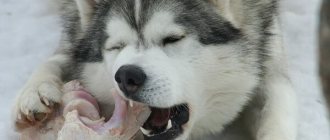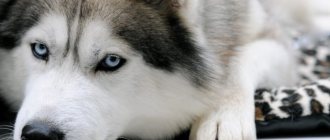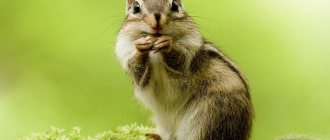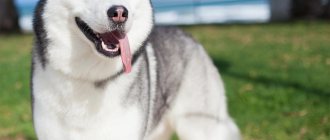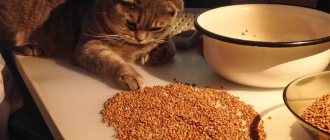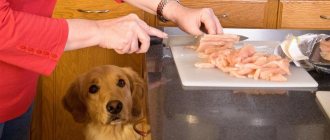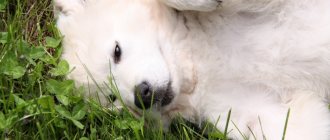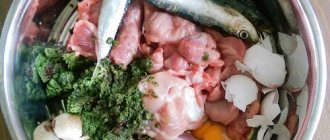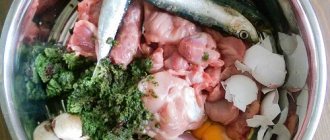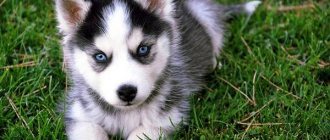Husky is an amazing breed, characterized by activity, energy and endurance. In order for dogs to remain this way throughout their lives, they need to be provided with a special diet. This applies most of all to little Khasen children, who are just developing their immunity and health. First, they decide whether it is better to feed a husky puppy, dry food or natural food, and then they select food that matches the metabolic characteristics and functioning of the baby’s digestive system. The owner must know all the subtleties and rules of creating a diet, following a diet, and calorie content, since the stomach is the most vulnerable place for hasyats.
Healthy eating
To ensure that your dog receives the necessary nutrients and the food is balanced, you need to follow the following tips on food composition and portion distribution:
- Most of the husky's menu consists of lean meat. The basis of the diet is chicken and turkey. During the week, it won’t hurt to add rabbit or veal.
- Vegetables should be boiled. This method of heat treatment can be applied to white cabbage, cauliflower, zucchini, and pumpkin. Huskies can eat carrots and cucumbers raw.
- Buckwheat and rice cereals make up about 10% of the diet.
- Kefir and cottage cheese are good choices for fermented milk products. For variety, you can finely chop or grate an apple.
What to feed a puppy
The appearance and health of an adult dog depends on the puppy’s nutrition. Therefore, it is very important to choose a balanced feeding.
All lines of ready-made food produce food specifically for puppies - more nutritious. Which contains more fat and carbohydrates, vitamins and microelements necessary for the normal development of the dog.
The choice of type of food - natural or dry - depends only on the wishes of the dog owner. The main thing is to choose the balance of nutrients based on the needs of a particular puppy.
If everything is clear with ready-made industrial food or canned food, then with natural food it is not so simple - based on the energy needs and living conditions, the puppy’s diet is selected.
A puppy of such an active breed as the Siberian Husky needs a lot of energy. Husky is a dog with protein-fat metabolism , unlike other breeds with protein-carbohydrate metabolism. Huskies need less carbohydrates and plant fiber than other breeds. But thanks to a special metabolism, fatty foods are absorbed well without harming the liver or pancreas.
Proper nutrition – 70% of the diet (for both an adult dog and a puppy) is meat and offal . This can be any type of meat, if the dog is not allergic - chicken, beef, duck, lamb, rabbit. The exception is pork, although lean pork is allowed, but rarely; this type of meat should not form the basis of the meat diet.
A mandatory product for the development of a puppy is the bone component and cartilage. The older the dog, the larger the bone - when changing teeth, and after changing teeth to clean them. The bones should have meaty residue, with cartilage and joints, the size of the bone is larger than the dog can swallow - this is a treat that helps massage the gums and clean the teeth of plaque, preventing caries. The bones must be raw - heat-treated bone will break off and the sharp fragments will damage the mouth, gums or internal organs if the dog swallows the fragment. Under no circumstances should tubular bones be given.
Cartilage and articular parts are an essential part of the diet, because gives collagen and helps in the development of one’s own cartilage - it is useful to give collagen at an age when the ears “stand up” and joints are forming.
From a young age, you need to accustom your dog to vegetables and fruits - these products contain fiber, which improves digestion and absorption of nutrients. Thanks to plant fibers, intestinal motility improves and correct and timely stool is formed.
During the period of skeletal growth, the puppy needs calcium - it is found in dairy products, but not all dairy products are absorbed by the dog. At a young age, milk is easily digested by a puppy due to the sufficient amount of lactase enzyme in the body. The composition of cow's milk is not suitable for dogs; it is better to give goat's milk. But everyone, without exception, both adults and puppies, needs fermented milk products. A puppy’s diet must include cottage cheese (fat content up to 9%, for an adult dog – up to 5%), yoghurts without sugar or filler, and kefir.
Hard cheese is suitable as a treat and for training.
Phosphorus, which is found in sea fish, is also needed for bone formation. This is also a must-have item for dogs of all ages, especially puppies. For a small puppy, it is better to give fillet without bones, for older ones - with crushed bones, so that the dog does not choke on the bone. For an adult dog, you can cut the fish into pieces or give it whole.
An important product that should be included in the diet are eggs - chicken, but preferably quail. Teenagers and adult dogs are given quail eggs, washed with the shell, raw.
Diet in the first month
The first complementary foods are given from three weeks of age - this is the food that will be the main diet in the future. If it is dry food, then it should be soaked to a mushy state in milk, similar in composition to bitch milk. Powdered bitch milk is now produced and can be purchased at pet stores or pharmacies, identical in composition to natural dog milk.
Dry foods have different compositions depending on the age of the dog - many are produced for the first feeding, for example Royal Canin starter (contains more protein).
If the puppy eats natural food, then the first complementary food should also consist of meat products. While the puppy’s teeth are just beginning to form, the meat is given in a minced state—thin fibers are scraped off a piece of meat with a knife. Start complementary feeding with hypoallergenic meat - lean beef, lamb or turkey.
Regardless of the type of food, the first complementary feeding should be about 5-10% of the main diet, gradually increasing the percentage of main feeding and replacing mother's milk. The transition to a new diet should be smooth and takes about a month. By 2 months, the puppy completely switches from mother's milk to a new diet.
From a month to six months
During this period, the puppy's skeleton is forming and its teeth are changing. This is the most important period of a dog’s growing up, when good, balanced and proper nutrition is required, on which the health and appearance of an adult dog depends.
At the age of 2 months, the dog has already been switched to the main diet - dry food or natural food. If the line of dry food includes food for the puppy after the first feeding, from 2 months the puppy is gradually transferred to the next type of food, which will be the main one until the dog grows up. Milk is removed from feeding, dry food is not soaked, the portion of food increases as the puppy’s weight increases, and the number of feedings during the day decreases.
In natural nutrition, the same principle applies - the portion gradually increases and the number of feedings decreases. But, unlike dry food, variety is introduced into the diet. During the main period of growth, before the closing of “growth points”, i.e. Before the formation of cartilage and ligaments, it is imperative to maintain a balance of calcium and phosphorus and add collagen.
New foods are gradually added to the puppy’s diet - new types of meat, fish, eggs (for small puppies - only quail, without shells), vegetables and fruits. Each type of product must be introduced gradually, the body’s reaction to the new product must be observed, and if there is no allergy, then a new product must be introduced. From 2 months, they are given one type of meat - preferably chopped lean beef - and cottage cheese with a quail egg without a shell. If these products are digested well and do not cause allergic reactions, add another type of meat, a small amount of offal, add kefir, yogurt and vegetables. For the first acquaintance with vegetables, zucchini, carrots or cucumbers are suitable. One type of vegetable is crushed into a pulp and mixed with the usual meat. It is imperative to observe the body’s reaction to the product - if no negative reaction occurs to mono-nutrition within a week, you can add the next one.
When a puppy is teething, it is imperative to give him bones and cartilage. The puppy will cope with cartilage tissue on his own and will not only enjoy the massage of the gums, but also benefit from the formation of his own cartilage. The bone is given for a while - as a treat or game. When the puppy, having played enough with the bone, leaves it, the bone must be removed; the puppy must not be left with the bone unattended to avoid injury if a sharp fragment breaks off from the bone.
From six months to a year
At this age, the “growth points” usually close, the skeleton is fully formed, a complete set of teeth is formed, and the position of the ears is fixed. Eating becomes less frequent, but the portion size should be appropriate to the dog's weight.
A dog becomes an adult at about a year and a half, and until this age the puppy should receive vitamins and supplements with food.
In the lines of dry food, the age of six months is usually not distinguished - feeding does not change from 2 months to a year, and with natural feeding from six months to a year, the dog receives and gets used to the main set of products - all types of meat, plant fiber, fish and dairy products, which will form her main diet in adulthood.
According to indications, the veterinarian prescribes additional vitamins for the puppy or adjusts the diet so that the balance of all the necessary elements for the development of the dog is maintained.
Natural food
This food option was considered the main one and preferred over dry food. Despite all its benefits, it is not easy to provide this for a husky at home or in an enclosure.
This is interesting: How nutrition affects the lifespan of a husky
Benefits of a natural diet:
- no useless or harmful additives;
- eat proteins, fats and vitamins with a natural diet;
- independent quality control of prepared food.
Disadvantages of this feeding:
- long time for preparation and processing of products;
- It is advisable to consult a veterinarian for the correct selection of nutrition;
- If you need to switch to dry food, many difficulties arise. At first, after a home-cooked meal, huskies don’t want to eat it.
Meat tenderloin and offal make up a significant part of the diet. Lungs, chicken or beef liver, kidneys, and heart are well suited for this. Sometimes food can be varied with sea fish without fat and bones.
The following vegetables and herbs are suitable for dogs:
- beet;
- carrot;
- zucchini;
- cucumbers;
- pumpkin;
- spinach;
- lettuce leaves.
Usually they are given crushed or pureed as an independent dish with sour cream or sunflower oil. You can prepare a vegetable mixture and add it to the meat.
This is interesting: Fruits that you can pamper your pet with
For huskies, you can cook porridge in water or meat broth; no salt is needed. Rice, buckwheat, and oatmeal are good cereals. Barley and millet should not be cooked.
In the morning, it is advisable for the dog to eat kefir, cottage cheese with sour cream, and yogurt without additives. Once a week you can give your pet boiled eggs.
Expert opinion
Anna Abramenko
An avid dog lover. Experience in veterinary medicine since 2009.
Ask a Question
To avoid intestinal obstruction, you should not feed your animal minced meat. The husky does not have chewing teeth; it will swallow it in pieces, which will lead to problems with the gastrointestinal tract.
What not to give
There are foods that you should not give to your dog:
- Boiled meat is not harmful, but does not provide any nutritional value for the dog, because... most of the nutrients remain in the broth, and meat broth often has a laxative effect. With natural nutrition, an acidic environment is formed in the gastrointestinal tract, which breaks down raw meat and bones, and the beneficial nutrients of the product are completely absorbed.
- Porridge is a filler that gives you a feeling of fullness, but has no nutritional value. The intestines of a predator are short, and grain requires longer digestion than meat, so porridge passes through the dog’s body in “transit,” bringing no benefit, but creating a feeling of fullness.
In addition to undesirable foods, there are prohibited foods that harm the body:
- Chocolate contains theobromine, which tends to accumulate in the body and leads to the development of diabetes, cardiovascular problems, seizures, and in excess, leads to the death of the pet.
- Sugar - found not only in candy, waffles or cookies, even in bread - foods containing sugar are contraindicated for dogs. Sugar destroys tooth enamel, leads to obesity, diabetes, and cardiovascular diseases. (see can dogs be given sweets)
- Boiled bones have no nutritional value, but break off into sharp fragments that injure the dog’s insides. For the same reason, it is forbidden to give tubular bones.
- Some types of fruits are grapes, candied fruits (due to their high sugar content), citrus fruits. (see why you shouldn't give grapes to dogs)
- Salty, spicy, smoked.
Types of feed and classification
Despite the many advantages of natural products, veterinarians recommend giving huskies dry food. Its manufacturers take into account all the physiological features of this breed. The mixture for them differs from universal food in its high content of protein and healthy fats.
Interesting article: Husky colors: white, red with blue eyes, black and brown
Dry food is divided into the following categories:
- Economy class - not very healthy varieties with low quality. They contain almost no meat and contain a lot of dyes and grains.
- Premium is a more nutritious food with offal and legumes.
- Super-premium class - high-quality mixtures with properties identical to natural products. The composition contains meat, fish, vegetables, healthy grains and hypoallergenic substances. There are no fillers or preservatives harmful to animals.
- Elite - varieties of the best quality. In addition to protein products, berries and vegetables, medicinal herbs are added to the feed.
For the Siberian Husky, super-premium and elite class are suitable. Usually they buy foreign food with formulas for active medium-sized animals. They are sold in special veterinary pharmacies or pet stores.
In the ranking of dry food for huskies, the leading positions are occupied by the following brands. The top column of the table corresponds to the first place in terms of properties and indicators.
| Name | Class | Description |
| Nutra Gold | Super premium | For active breeds, strengthens the spine and bones, improves the condition of the coat. Suitable for feeding puppies |
| Advance | Premium, super premium | Contains all necessary substances, hypoallergenic, prevents the occurrence of diseases of the genitourinary organs |
| Purina Pro Plan | Premium | There are several types of food for huskies. Additionally, you need to give vitamins and plenty of water. |
| Royal Canin | Super premium, elite | Wide selection of different lines of dry mixes. Wet canned foods are also available. |
| Happy Dog | Premium | Inexpensive but reliable German food with a varied composition and only natural additives |
For adult dogs
As the dogs approach a year, they are switched to a new diet. Remember that puppy formulas are not suitable for adult huskies: the abundance of vitamins is intended for growth, and when the animal matures, excess vitamins lead to health problems. Once you select the formula you want, do not change it.
The northern breed does not need variety. Using one selected food will keep the animal's digestive organs in optimal condition. For an adult pet, hypoallergenic Sensible Nutrition brand Happy Dog or Fit&Well is well suited. Royal Canin offers a Medium Adult formula for Huskies.
From the age of one year, huskies are fed no more than twice a day. Eating a single meal can cause volvulus. Do not feed food immediately before bed. You should not feed your pet if you have to travel by transport. In order for food to be better absorbed without causing intestinal irritation, dogs should be fed in a quiet, calm environment.
Siberian huskies and huskies are active sledding breeds with a fairly low metabolism. They do not require large amounts of food. If the dog is deprived of the opportunity to burn calories, he may even refuse food.
Dilute the dry diet with wet canned food from the same company. As a reward, use special delicacies made from natural protein, which does not lead to obesity or allergic reactions.
Power types
Before preparing a husky diet, the owner must choose 1 of 2 options for his pet - natural food or special dry food. Mixed nutrition is strictly contraindicated for representatives of northern breeds.
This common mistake by owners leads to major health problems in animals. In addition, it is strictly forbidden to feed a dog from a common table and treat it with something tasty for a person, but destructive for a pet.
With any feeding option, the diet must contain the amount of protein required by the husky’s body. If you feed your dog only porridge and vegetable soup, the animal will grow up sickly, weak, and with a lack of muscle mass.
Despite the large parameters of the representatives of the breed, moderation in their diet is very important. Overeating and starvation are equally harmful for huskies. Due to the peculiar nature of metabolism, you need to strictly adhere to the serving size, regardless of the type of food.
Prohibited Products
The following foods should not be given to your dog:
- any minced meat;
- potato;
- whole milk;
- tubular bones;
- pork;
- lamb;
- bread, loaf and other baked goods;
- pasta;
- chocolate, sugar and other sweets;
- tomatoes;
- grape;
- fried, spicy, salty, smoked dishes.
- lean meats;
- offal;
- bones - not to be given as food, but to be chewed to prevent caries;
- oatmeal, buckwheat, rice porridge;
- sea fish;
- eggs and dairy products;
- vegetables;
- vitamin complexes.
For an active lifestyle and endurance, Huskies should eat:
- lean meats;
- offal;
- bones - not to be given as food, but to be chewed to prevent caries;
- oatmeal, buckwheat, rice porridge;
- sea fish;
- eggs and dairy products;
- vegetables;
- vitamin complexes.
Expert opinion
Anna Abramenko
An avid dog lover. Experience in veterinary medicine since 2009.
Ask a Question
Fruits are mostly a treat as a form of praise for the dog, so they are not given as often. Citrus fruits are allergenic foods; it is best not to feed them to huskies.
List of prohibited products
- Fish, tubular bones.
- Ground meat.
- Pork.
- Spices, spices, seasonings.
- Legumes.
- Bread and other flour products.
- Smoked meats.
- Salt.
- Pickled, spicy food.
- Roast.
- Chocolate, sugar, sweets, candy.
- Raisin.
- Grape.
- Apricots.
- Potato.
- Honey.
- Nutmeg.
- Alcohol.
- Coffee.
The arrival of a Siberian Husky puppy in your home is a wonderful event. For your pet to be active and healthy, it needs proper care and nutrition. Using this information, you will not have problems with your puppy's nutrition, and your pet will be happy and cheerful for many years.
Diet
When selecting a diet, not only the necessary substances are taken into account, but also the age, gender of the dog, and its preferences.
For puppies by month
The best food for a one-month-old puppy and younger is mother's milk, after which complementary foods can be introduced.
The baby husky is fed freshly prepared food, which should be given warm.
If he has not eaten in 20 minutes, you need to remove the plate until the next meal. It is most preferable to feed low-fat cottage cheese, fruits, omelettes, meat with porridge, kefir, carrots, and beets from 2 months.
From this age, milk can no longer be given to dogs. Little huskies love to eat sweet fruits, especially apples and bananas. But you need to make sure that their use does not harm the animal.
Expert opinion
Anna Abramenko
An avid dog lover. Experience in veterinary medicine since 2009.
Ask a Question
The daily allowance of meat must be strictly observed, new food should be introduced carefully and gradually so that the small pet does not develop a stomach ache.
If we consider dry artificial food for husky puppies, it is better to choose a super-premium or elite variety, focusing on age. And within 1 month you need to dilute a special mixture and make sure that it has a uniform consistency without lumps.
For an adult dog
It is much more important to maintain a balanced diet. You can give more fish, and vegetables can be cut into small pieces rather than pureed.
It is much more important to maintain a balanced diet. You can give more fish, and vegetables can be cut into small pieces rather than pureed.
For a nursing bitch
During pregnancy, your Husky needs to gradually increase the dose of protein food.
If she was given branded food, then she should not be abruptly switched to natural food - this can only harm future offspring.
During the last week of gestation and on the 5th day after birth, it is necessary to exclude meat and fish from the diet. The bitch and her puppies must be treated with extreme care during this period, cared for and cared for.
For pregnant women, allergy sufferers, elderly
Pregnant and lactating huskies need a richer, fortified diet. Puppy formulas are suitable for them. Some companies offer separate series for pregnant women. In particular, Royal Canin produces Medium Starter food, which is suitable for bitches who need a special diet.
Huskies are a hardy, kind, intelligent breed, but even these strong dogs are susceptible to various diseases.
If your dog has problems with the gastrointestinal tract, Concept food from the Happy Dog brand or Royal Canin Medium Digestive Care is suitable. For dermatitis – Royal Canin Medium Dermacomfort series. If Huskies are prone to hypertension, it is recommended to switch to the Innova Evo formula. If tumors are found, receive food from Grandorf and Acana companies.
Castrated or neutered dogs need mixtures low in lipids and carbohydrates. Thanks to this, it will be possible to protect your pet from obesity and related diseases. For animals prone to obesity, Royal Canin – Medium Light Weight Care is suitable.
Aging dogs exercise little and they also need a special low-calorie diet. The following Royal Canin products are recommended:
- Medium Adult 7+, for pets from 7 to 10 years old;
- Royal Canin Medium Aging 10+, for dogs over 10 years old.
Feeding frequency and portions
The number of meals per day directly depends on the age of the dog - the older it is, the fewer times it eats.
| Age in months | Number of feedings per day | Hourly schedule |
| 1-2 | 6 | 7:00, 10:00, 13:00, 16:00, 19:00, 22:00 |
| 2-3 | 5 | 7:00, 10:00, 14:00, 18:00, 22:00 |
| 3-4 | 4 | 7:00, 12:00, 17:00, 22:00 |
| 4-6 | 3-4 | 7:00, 13:00, 18:00, 22:00 |
| 6-10 | 3 | 7:00, 13:00, 21:00 |
| From 10 and older | 2 | 7:00, 21:00 |
Sometimes an adult husky has a poor appetite. Don't panic - these dogs by nature don't eat much, and sometimes they indulge in food fasting, especially in hot weather. But if your pet does not eat anything for more than two days, you need to consult a doctor.
Expert opinion
Anna Abramenko
An avid dog lover. Experience in veterinary medicine since 2009.
Ask a Question
It is imperative to adhere to the established meal schedule and not deviate from it.
Reviews
Tatyana, Taganrog
“I must admit, I fed my husky natural food almost all of her life. And only when the dog’s health began to deteriorate, on the advice of a veterinarian, she switched it to a special super-premium formulation for older animals. The dog’s condition has changed so much that even the fur, which was already graying and falling out, was renewed, became fluffy, thick, and bright. I couldn't believe my eyes. Simply great! It feels like my husky has a second youth.”
Andrey, Kemerovo
“Being a professional breeder of Husky dogs, I have been feeding them dry formula for eight years now. I choose products only from leading developers. Lately it's been mostly Acana. There are no complaints. The dogs are healthy, active and happy.”
Veterinarian recommendations
Andrey, Moscow: “Husky dogs are prone to obesity, so you should not feed her a lot or in too large portions. If the dog has not eaten within 20 minutes, we remove the food. He doesn't eat that much per day thanks to the metabolism they got from the wolves. But this does not mean that the dog should starve - be extremely careful and responsible with its nutrition.”
Yulia, Krasnodar: “Husks are amazing animals, even when it comes to food. Despite their unusual appearance, they are not picky. But you need to strictly follow the feeding schedule and not give your dog prohibited or allergenic treats. Food from the master’s table is taboo for huskies, even small children who love to treat pets should know this.”
Vyacheslav, Sevastopol: “Blue-eyed northern dogs love not only to frolic, but also to eat deliciously, despite their unpretentiousness in food. Therefore, the owner must control the schedule and balance of nutrition, otherwise the dog will turn into a fat fluffy ball, and it will be difficult for him to even walk.”
Even in feeding, huskies remain special dogs; close attention is paid to their nutrition. The main thing is to keep it balanced and remember the prohibited foods for this breed.
Despite the strong endurance and activity of Siberian dogs, their stomach is the most vulnerable organ, so eating unwanted food can lead to serious illnesses.
Benefits of dry mixes
Developers of nutritional formulas for dogs continue to improve, constantly coming up with new healthy foods. The diet of northern breeds based on industrial mixtures has a number of noticeable advantages:
- Balanced dry food already contains all the necessary micro- and macroelements, which has a positive effect on the health and beauty of the dog.
- High-quality formulas contain a maximum of animal protein and a minimum of herbal additives.
- Dogs eat the product with pleasure due to its attractive taste and aroma.
- The food is well saturated.
- It doesn’t take much time to select a menu. When you buy a bag of dry food, you know exactly what you will feed your dog tomorrow or in a week.
- Dry mixtures are easier to take on the road.
- Easy to calculate portion sizes.
- No additional vitamin and mineral supplements are needed.
- Thanks to the variety of formulas, you can choose the food that suits your dog.
- Dry mixtures are stored much longer than food from the master's table.
Separately, it should be noted the advantages of feeding with breed mixtures:
- the shape of the granules is selected taking into account the structure of the animal’s jaw;
- The size of the croquettes is such that they are easy to swallow;
- Thanks to the texture of the granules, the dog's teeth are cleaned.
